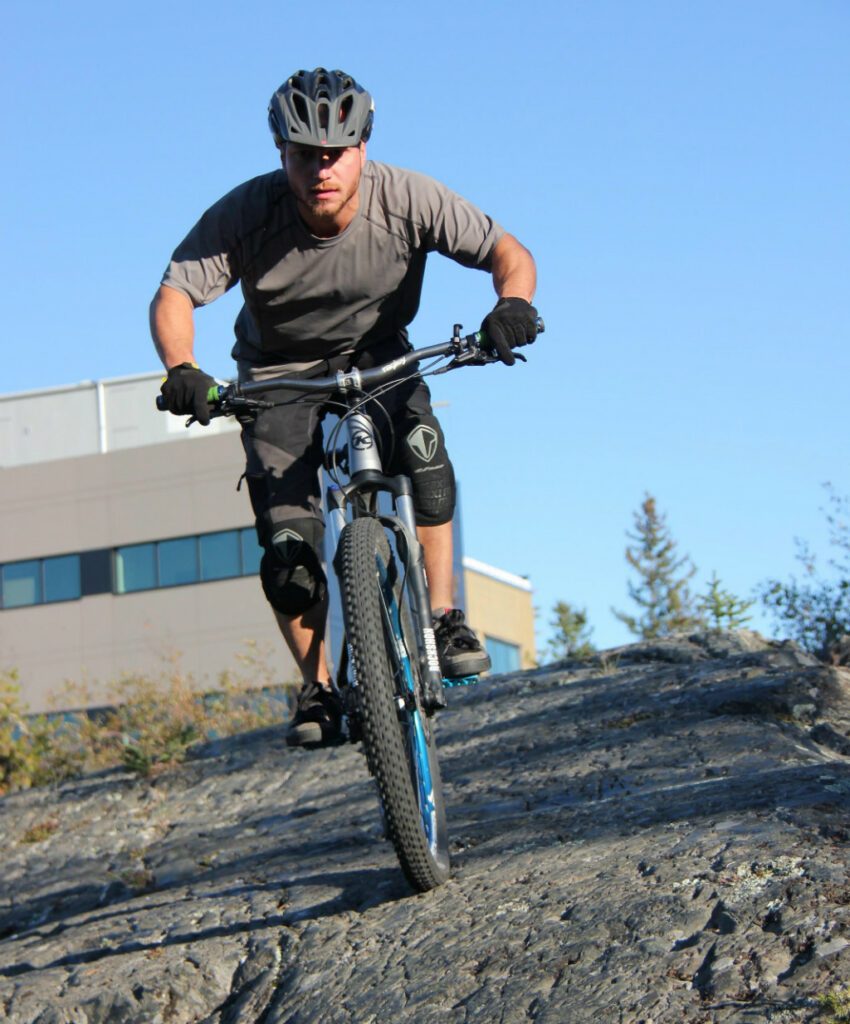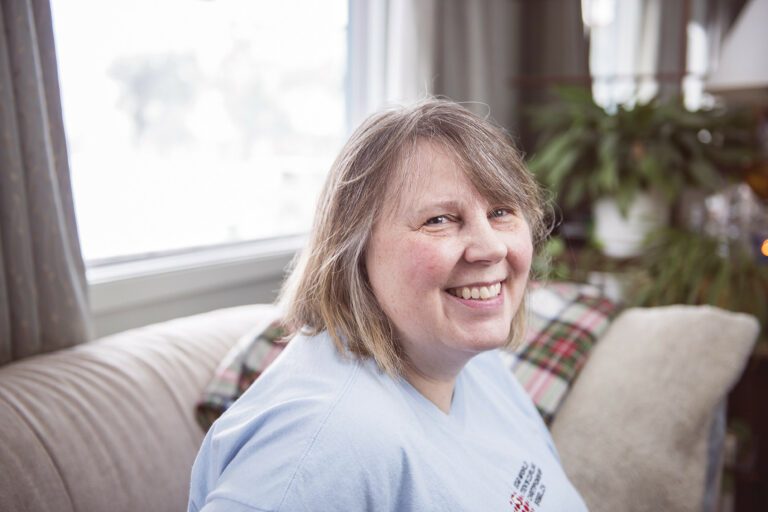Geoff Foster’s truck is easy to find. A virginal white Xterra wearing a bright yellow canoe hat, it’s parked where he said it would be, just past the Dettah junction on the Ingraham Trail. Foster, not so much. It’s a bright September day and he’s somewhere on The Holdout, a trail he has been building with the help of friends in the Yellowknife Mountain Bike Club.
The Holdout starts on the north side of the highway and climbs quickly through a copse of stunted spruce and birch. Lichens and bearberry have been scuffed down to bare rock to make the path visible. It’s easy and technical by turns, as it loops for more than a kilometer around and over a rocky knoll.
Foster started riding five years ago, just before he left Ontario, but parked his ride when he got to Yellowknife. The naked rock and abrupt verticals were too intimidating. Then last year, he met Rob Lok, who introduced him to the thrills of riding the Precambrian Shield and a small group of riders who know their way around the few trails the city has to offer.
Compact and muscular, Foster has the physique for the balancing act required when a bike is resisting forward motion, and the boundless enthusiasm of a rider still discovering how much fun a bike can be. His ride is a full suspension Kona with upgraded parts that push its replacement value close to $5,000.
This year, Foster started organizing club rides – usually every Wednesday after six. When he isn’t riding, he’s an IT specialist. He developed a Facebook page for the club and started posting trail details to Trailforks, an international repository for trails developed by Pinkbike.
On a trip to Vancouver and the legendary trails on the city’s North Shore, Foster saw trails that offered options. Skilled riders could take a challenging line that led to a jump, or narrow bridges over deep drops. Those less confident in their abilities could detour without stopping or dabbing a foot for balance.
The North Shore, he observed, is home to a large community of riders and volunteers, with financial support from local government for trail maintenance and development, including signage that marks where trails begin and end, with ratings for the level of difficulty.
Build it and they will come
The story is the same in Whitehorse, where local government has been involved since a 2005 commissioned study suggested that a developed trail system could attract as many as 4500 riders a year from a demographic of young, educated males and a growing number of women with money to spend on their passion for mountain biking.
A single sponsored race could bring as much as $600,000 to the city, and over a year, add $10 million to Yukon tourism revenues. At the time, Whitehorse had spent about $200,000 to develop 500 km of multi-use trails. A 10-year plan for trail development has generated $1 million in contributions from city, territorial and federal governments and NGOs.
The investment caught the attention of Outside and Bike magazines, and put Whitehorse on the map for adventure travelers. Business has surged for tour companies and bicycle shops, and the trails are now among the top reasons newcomers give for moving to the city.
Doug Hnatiuk, manager of parks and community development for Whitehorse, has overseen the trail development program, and is clearly pleased when he notes that a counter on the popular Millenium Trail recorded 300,000 visits last year – “impressive for a city with a population of just 28,000.”
“People take great pride in the trails; they chose the trails as the city’s top amenity,” he told Edge. Whitehorse spends $150,000 a year on trails, divided equally between maintenance and development, and has plans to link the city’s widely separated neighbourhoods with commuter trails that are separate from the streets.
Details on the trail budget in Whitehorse left Foster momentarily speechless. “That much?!”was what he finally said, and then wondered, how much more he could do if he could locate a source of clay for the trail base, and ferry it in with a helicopter. “It’s $1,500 an hour, but I could get a lot more done.”
The Contagious Mountain Bike Group in Whitehorse has more than 300 members – “large enough for weekly rides for just women, and we can rarely get women to come out, but we’re just starting out,” Foster said.
The Yellowknife Mountain Bike Club currently has fewer than 40 members and a core of about 25 riders. “We’re in our infancy. There’s no pool of tools, or equipment or money, but it’s just a matter of growing it. The terrain is good to practice on, really technical, with nice steep grades, but not enough trails.”
According to the Trailforks entry for Yellowknife, the city has about 20 km of trails: Tin Can Hill, A and B; Holdout; Frame Lake; Prosperous Lake; Junior Bush Pilot; Auto Pilot; Prelude Lake; Funeral Tour; Jackfish and Wardair.
A BMX course and a skills park for mountain bikers would be welcome additions, and inexpensive to build – if the city was interested in making the investment, said Foster, who believes that “if you build it, they will come” and Yellowknife could pull in cycling tourists, just as Whitehorse has.







